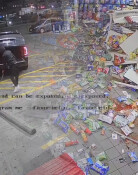A large sinkhole in central Seoul causes fatality
A large sinkhole in central Seoul causes fatality
Posted March. 26, 2025 07:43,
Updated March. 26, 2025 07:43
On March 24, a massive 20-meter-wide and 30-meter-deep sinkhole appeared on a road in front of Hanyoung Foreign Language High School in Gangdong District, Seoul. One passing motorcycle fell into the hole and the rider was buried dead in debris. Other passenger cars barely escaped the fall, however the accident could have been much worse as the sinkhole spanned four out of six lanes. The Seoul Metropolitan Government decided to temporarily suspend the construction extending the Subway Line 9 near the site as it is considered a possible cause of the collapse.
A total of 216 sinkholes were reported over the last 10 years in Seoul alone. Just last year, in August, a sinkhole measuring 6 meters wide and 4 meters long appeared on a road in Seodaemun District, near the direction of Seongsan Bridge. Additional sinkholes also appeared near Jongno 5-ga Station and Eonju Station, causing public anxiety. In downtown Seoul, where there is heavy vehicle traffic and a large floating population, sudden ground collapses pose a significant threat to both drivers and pedestrians. The unpredictable nature of those accidents can lead to large-scale disasters.
Sinkholes in urban areas are mainly caused by man-made factors such as underground development like subway and tunnel building, or constructions of roads and buildings. Inadequate ground reinforcement works cause underground water or sewage pipe leaks, which in turn move soils, creating a void beneath the surface. Various construction works were going on simultaneously near the sinkhole in question, including the subway No. 9 extension, the construction of the Sejong-Pocheon highway, which opened in January, and some reconstruction of old apartment buildings. When multiple construction projects occur simultaneously, changes in underground water pressure and soil erosion accelerate, increasing the risk of sinkholes.
Frequent ground condition inspections and thorough monitoring of underground facility development can partially prevent sinkholes. The latest sinkhole incident had several warning signs before it happened. Gas stations and stores nearby filed multiple complaints regarding cracks forming on the floors. The Ministry of Land, Infrastructure and Transport conducted a special inspection, followed by an on-site checkup by the Seoul Metropolitan Government and Gangdong District Office, and even the construction supervisor and constructor visited for a site inspection. Still, no signs of ground subsidence were detected. Authorities must investigate whether the inspections were inadequate or if the current ground exploration technology and equipment are insufficient to prevent future occurrences. The safety of roads used daily by citizens for commuting cannot be left to mere luck.




![탈성매매女 “이달 지원금 540만원으로 줄어” 불만글 시끌 [e글e글]](https://dimg.donga.com/c/138/175/90/1/wps/NEWS/IMAGE/2025/12/26/133040473.3.jpg)


